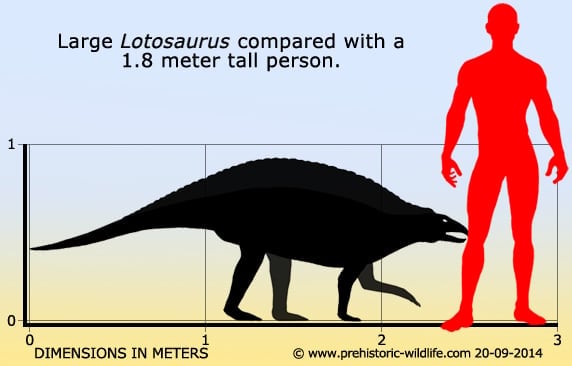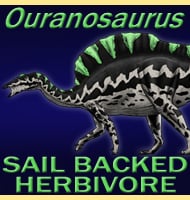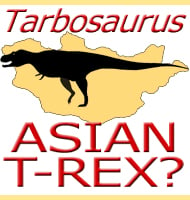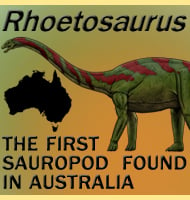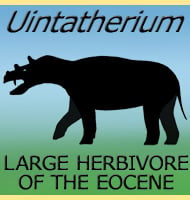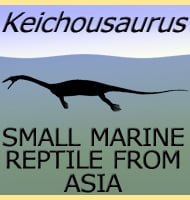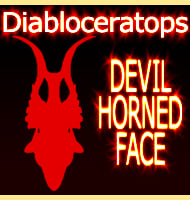In Depth
Sail-backed rauisuchian archosaurs are not especially well known, but they do seem to have existed in reasonably high numbers, although it is also important not to confuse them with the earlier sail-backed pelycosaurs of the Permian such as Dimetrodon and Edaphosaurus. Upon is initial discovery and description, Lotosaurus was thought to have been one of the ctenosauriscids, sail-backed thecodont archosaurs such as Ctenosauriscus and Xilousuchus. Further fossils and later study have now placed Lotosaurus within the Poposauroidea, a sister group that is separate to the ctenosauriscids.
Like with others of its kind, Lotosaurus was a quadrupedal reptile, although it had a more rotund body than its relatives which have been confirmed as being carnivorous. This indicates that Lotosaurus was not an overly active creature and as such was not a main predator of the ecosystem. However this does not answer what Lotosaurus ate as the toothless jaws may have served two possible dietary preferences, either that of a plant eating herbivore or a shellfish eating durophagovore. Aside from being toothless, the only other things of note about the jaws of Lotosaurus is that the upper curved down and that they seem to have had a powerful bite, but again these do not give much indication towards one diet over the other.
What does give us an indication as to what Lotosaurus ate is analysis of the fossil sites that Lotosaurus fossils are known from. So far the one unifying factor of these sites is that they were all wetland areas and this is where many researchers sway more towards a duropohagous diet. You see if Lotosaurus had lived in a dryer more arid habitat, it would have been feeding upon tougher plants that would require a strong bite. The vegetation growing in wetland habitats however is usually much softer and easier to pull free because plants do not have to adapt to survive in a harsher climate. A strong bite would be an unnecessary adaptation for a herbivorous diet in a wetland ecosystem, but it would be very useful for cracking open shellfish that would have also been abundant in a wetland habitat. Also remember that even though it is not out of the question that archosaurs can adapt to a vegetarian diet, others that Lotosaurus would have been related to (even if albeit distantly) were carnivorous. This means that even Lotosaurus would quite possibly have had to survive upon animal protein that it obtained from the soft internal bodies of shellfish and since these could not run away, Lotosaurus did not have to adapt to become an ambush or pursuit predator. On a final note about diet, the shape of the jaws could have been adapted for pulling vegetation, but could have also been used for picking out shellfish from amongst others, the curvature of the jaw hooking around the round shells of shellfish.
The sail on the back of Lotosaurus obviously had a purpose but so far there is no way of confirming exactly what this purpose was. Thermoregulation is a steadfast proposal for such features and one that is entirely plausible. The one main problem with this theory however is that not all rauisuchians had sails, in fact those that do are so far in the minority when it comes to fossils. Additionally those that do such as Arizonasaurus and Ctenosauriscus have sails that are quite different to the sails of Lotosaurus and its kin. Logic would dictate that if thermoregulation was the defining factor, the sails would be more standardised in form. However this does not put the theory to rest completely as since Lotosaurus lived in wetlands it would likely have a greater exposure to the cooling effects of airborne moisture and water. It is also plausible that Lotosaurus may have even entered the water to feed upon plants or even shellfish and a sail rising up from the back to catch the sun’s rays while other parts of the body were submerged would have helped to keep body temperature high.
A theory that at least goes some way to explain the variance between the sail forms of different genera is display. Here the sail would allow Lotosaurus to recognise others of its own species as well as possibly be coloured or patterned to attract a mate. It is also important to remember however that a feature such as sail doesn’t have to have just one purpose and may have in fact worked to all of the above theories.
Further Reading
– A new thecodont Lotosaurus, from Middle Triassic of Hunan. – Vertebrata PalAsiatica 13:144-147. – F. -K. Zhang – 1975. – Taphonomy, geological age, and paleobiogeography of Lotosaurus adentus (archosauria: poposauroidea) from the middle-upper triassic badong formation, hunan, china. – Palaios. 33 (3): 106–124. – Cedric J. Hagen, Eric M. Roberts, Corwin Sullivan, Jun Liu, Yanyin Wang, Prince C. Owusu Agyemang, Xu Xing – 2018. – New age constraints for the Middle Triassic archosaur Lotosaurus: Implications for basal archosaurian appearance and radiation in South China. – Palaeogeography, Palaeoclimatology, Palaeoecology. 521: 30–41. – Jun Wang, Rui Pei, Jianye Chen, Zhenzhu Zhou, Chongqin Feng & Su-Chin Chang – 2019.
